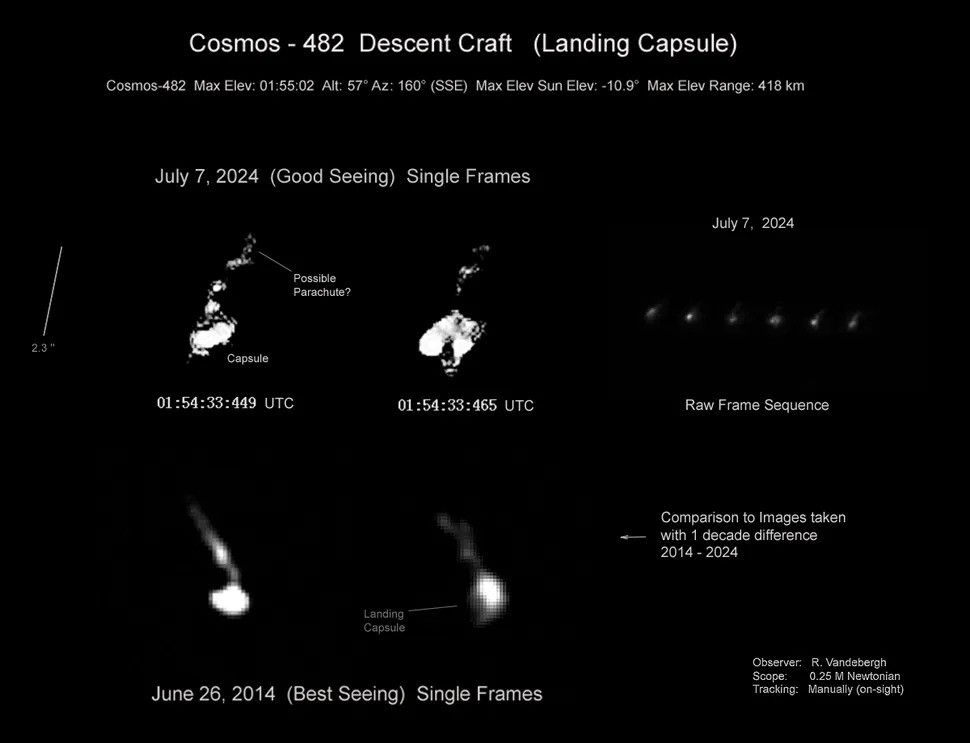The failed Soviet spacecraft Kosmos 482 will conclude its roughly 50-year jaunt through Earth’s orbit this weekend, with experts predicting it could crash back to our planet as soon as tonight (May 9).
The latest predictions from the European Space Agency (ESA) reveal that the Kosmos 482 Descent Craft is poised to reenter Earth’s atmosphere at approximately 2:26 a.m. EDT (06:26 GMT) on Saturday, May 10. The uncertainty for the prediction is plus or minus 4.35 hours, giving us an estimated reentry window of roughly 10 p.m. EDT Friday (May 9) to 7 a.m EDT Saturday, according to ESA.
Kayhan Space, a Colorado-based space technology company that’s also been tracking the craft, predicts an even narrower reentry window. At press time, the company’s latest estimate predicts a reentry time of 2:28 a.m. ET (6:28 GMT) on May 10, plus or minus 2.4 hours.
“The atmospheric density in the lower altitudes (50 to 300 km) [30 to 185 miles] is very uncertain, which can result in large prediction uncertainties,” Derek Woods, senior astrodynamics engineer at Kayhan Space, told Live Science in an email.
Where will Kosmos 482 land?

Falling like a meteor through the atmosphere, the roughly 3-foot-wide (1 meter), 1,091 pound (495 kilograms) craft could hit virtually anywhere on the planet. It could land at any point between 52 degrees north and 52 degrees south — an enormous swath of the planet that includes almost every major populated area — according to ESA.
Related: Doomed Soviet spacecraft tumbling toward Earth may already have its parachute out, new images hint
Luckily, the odds are overwhelmingly in favor of the spacecraft landing in the ocean, as most uncontrolled space junk reentries do. Experts won’t be able to narrow down the landing zone until hours before the reentry happens, due to the somewhat unpredictable effects of atmospheric drag.
The likelihood of the out-of-control spacecraft hitting a person is “the usual one-in-several-thousand chance” associated with falling space debris, Jonathan McDowell, an astrophysicist at the Harvard-Smithsonian Center for Astrophysics, wrote in a blog post.
What is Kosmos 482?
The Kosmos 482 probe was built and launched in 1972 as part of the Soviet Union’s Venera mission to explore Venus. The Soviets successfully launched the Venera 7 and 8 probes, which were the first two spacecraft to successfully land on Venus in 1970 and 1972, respectively.

Kosmos 482 was built as a sister probe to Venera 8. However, due to a malfunction with the Soyuz rocket that launched it into space, the probe failed to achieve enough velocity to reach Venus, instead getting stuck in an elliptical, or oval-shaped, orbit around Earth for more than 50 years — until now.
Designed to survive a fiery fall through Venus’ atmosphere, the Kosmos 482 Descent Craft is likely to stay in one piece as it crashes to Earth this weekend, Marco Langbroek, a lecturer in space situational awareness at Delft Technical University in the Netherlands who first discovered the lander’s imminent return, wrote in a blog post. It will be traveling at approximately 150 mph (242 km/h).
Part of a larger problem
While its intriguing history has earned the lander media attention, Kosmos 482 is just one of more than 1.2 million pieces of space junk in Earth’s orbit larger than 0.4 inches (1 centimeter), according to an ESA report published in April.
Orbital collisions and uncontrolled reentries are becoming increasingly common, with “intact satellites or rocket bodies … now re-entering the Earth atmosphere on average more than three times a day,” according to the ESA report.
The larger pieces of space junk come from a range of spacecraft, rockets and boosters that are big enough to survive reentry and reach the ground.
“We’re seeing a rise in reentries involving larger objects that can partially survive and reach the surface,” Woods said. “Some of these larger objects are defunct space race-era objects like KOSMOS 428 DESCENT CRAFT. These objects were in highly eccentric orbits and are now naturally decaying after decades in space.”
As the number of new satellites in Earth’s orbit increases every year, it will become more important than ever for missions to have “controlled end-of-life plans for large objects” and for space agencies to invest in debris removal technology, Woods added.
